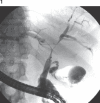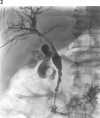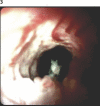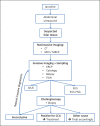Diagnostic Approach to Suspected Perihilar Malignancy
- PMID: 33718479
- PMCID: PMC7923842
- DOI: 10.1159/000513950
Diagnostic Approach to Suspected Perihilar Malignancy
Abstract
Background: Cholangiocarcinomas are relatively rare tumors most frequently arising from the epithelium of the hilar bile ducts. The diagnosis is often made in advanced (symptomatic) stages, which accounts for the infavorable prognosis with a 5-year survival of less than 10%. Identification of perihilar cholangiocarcinoma (pCCA) is often challenging because there is no single method offering sufficient diagnostic accuracy.
Summary: Most tumors arise in patients without specific risk factors. Clinical symptoms of pCCA are nonspecific and reliable biomarkers are lacking, with carbohydrate antigen 19-9 being the most commonly used tumor marker (but with a low accuracy). Cross-sectional imaging (CT and MRI) is used to identify and map hilar strictures and determine resectability by showing vascular involvement. Endoscopic ultrasound offers additional information on locoregional tumor spread and lymph node involvement. Endoscopic retrograde cholangiography in combination with cholangioscopy gives direct access to and imaging of hilar strictures but it does not always distinguish between pCCA and benign hilar strictures. Tissue acquisition for histological diagnosis is challenging, with frequent sampling errors regardless of the method of biopsy procurement because of the cellular paucity of tumor tissue.
Key messages: In suspected perihilar malignancy, a mosaic of clinical data has to be taken into account. Histological evaluation of (endoscopically harvested) specimens is pivotal to differential diagnosis. Several new techniques to increase diagnostic accuracy are under investigation (biomarkers and genetic testing among others).
Keywords: Biopsy; Cholangiocarcinoma; Cholangioscopy; Endoscopic retrograde cholangiopancraticography; Endosonography.
Copyright © 2021 by S. Karger AG, Basel.
Conflict of interest statement
The authors declare that there are no conflict of interests.
Figures







References
-
- Aljiffry M, Abdulelah A, Walsh M, Peltekian K, Alwayn I, Molinari M. Evidence-based approach to cholangiocarcinoma: a systematic review of the current literature. J Am Coll Surg. 2009 Jan;208((1)):134–47. - PubMed
-
- Khan SA, Davidson BR, Goldin RD, Heaton N, Karani J, Pereira SP, et al. British Society of Gastroenterology Guidelines for the diagnosis and treatment of cholangiocarcinoma: an update. Gut. 2012 Dec;61((12)):1657–69. - PubMed
-
- Yachimski P, Pratt DS. Cholangiocarcinoma: natural history, treatment, and strategies for surveillance in high-risk patients. J Clin Gastroenterol. 2008 Feb;42((2)):178–90. - PubMed
-
- Nault J-C, Villanueva A. Biomarkers for hepatobiliary cancers. Hepatology. 2020. doi:10.1002/hep.31175. - PubMed
Publication types
LinkOut - more resources
Full Text Sources
Other Literature Sources

